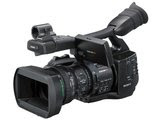September 24, 2008
At Densho, we’ve been shooting our oral histories with digital video since the early days of the technology. Back in 1997, after experimenting with several analog and digital formats (anyone remember Sony Digital Hi8?) we chose the Panasonic DVCPRO25 standard. It was becoming a established player especially in news-gathering circles, and of particular importance to Densho, the physical tapes were more reliable with a longer archival lifespan than competing digital formats.
It’s now a decade later and while DVCPRO25 served us well — our original Panasonic camera is still functioning like it’s brand-new — we decided that it was time to move on. High-Definition (HD)  video is not a completely novel technology, but over the last few years it has finally become accessible to smaller organizations like ours. There are professional-grade cameras for under $10K and desktop video editing tools like Final Cut Pro and Avid Express now support many HD formats.
video is not a completely novel technology, but over the last few years it has finally become accessible to smaller organizations like ours. There are professional-grade cameras for under $10K and desktop video editing tools like Final Cut Pro and Avid Express now support many HD formats.
But why HD? Is it just another fad? Do we really need it to record oral history?
First of all, the quality difference between HD and SD (Standard Definition) video is shocking. The size, clarity and color of HD images makes SD video look like the fuzzy black & white TV that was in the basement of my house growing up. HD is also here to stay. The government-mandated digital broadcast television plan is good evidence of this.
The important question, however, is why is HD important for Densho? From a purely technical standpoint, the issue is standards. Broadcasters, equipment manufacturers, content producers and software tool developers are all moving to HD. Being at the very cutting edge (or “bleeding edge”) of technology can be risky, but being left with an obsolete format is even more dangerous. Replacing our DVCPRO equipment and tape stock was already becoming more expensive.
The second reason is that video quality does make a difference. In our oral history practice, we usually have one chance to do an interview. It is critical that we capture that person’s unique story as best we can. All the forms of non-verbal communication — the gestures, the facial expressions — that come out in the course of a face-to-face interview are better preserved with HD.
The Migration
With generous grants from the Seattle Foundation and King County’s 4Culture we began the process of migrating our workflow and practices to support HD video early this year.
We selected Sony’s XDCAM EX tapeless format as our primary platform, and purchased a Sony PMW-EX1 camera. The EX1 is capable of full-frame 1920×1080 HD in a number of different profiles (for the video geeks out there, we shoot using the 1920@60i mode). Rather than recording to tape, the camera uses an SxS memory card, somewhat similar to the way consumer still cameras work. There are two card slots that the camera will swap when the memory card is full (about 1 hour on a 16GB card) so it is possible to shoot continuously by removing the card, copying the contents to a laptop while the interview is ongoing, and then reusing the card again. This does, however, mean that our videographer (and production manager) Dana sometimes must force the interviewer to take a break…
The new format also required a change in the way we were archiving the original video footage. Where we once had to store and preserve physical video tapes, we now can simply copy the digital video files to multiple physical (Blu-ray data disc) or virtual (network storage) locations with the confidence that the files are exactly what was recorded originally with no quality loss. (The astute archivists and information scientists reading this realize, of course, that it is not quite that simple, and that the assets must still be carefully managed, but I’ll write on that subject later…)
We had the chance to put the new equipment and our new processes to the test this summer. As you have read here, our crew travelled all over the west coast and mountain interior shooting more than 40 interviews. Ten are already up in the Densho Digital Archive.
Thus far, the HD migration project has been a success. Our next step is to update the way that we are delivering video to users of our website. But more on that next time.
A Short List of Densho’s HD Equipment
- Sony PMW-EX1 camcorder
- Sony HVR-M35U HD video deck
- Grass Valley Edius Broadcast 4.6 video editing system
- Grass Valley ProCoder 3 software transcoder